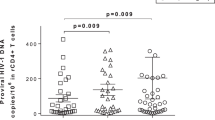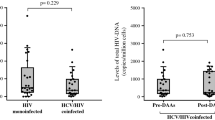Abstract
Resistance to HIV-1 infection in Europeans is associated with a mutation in the gene that codes for the CCR5 protein that is present in Th2 cells and serves as a coreceptor for HIV-1 R5 strain. A deletion of 32 amino acids from the cytokine receptor prevents infection. This mutation prevails in Europeans and is absent in Africans. However, duplication of a gene that codes for a chemokine that binds to the CCR5 was discovered in Africans (mean gene copy 6 while in non-Africans the mean gene copy is 3). Higher expression of these genes protects T cells against HIV-1 infection in vitro. It should be noted that resistance to HIV-1 R5 variant does not protect against HIV-1 R4 variant. It was reported that a minority of highly HIV-1 exposed African professional sex workers (APSW) were resistant to the virus infection during a 10 years period. Recently, the analysis of the cytokines in the serum of the persistently infected seronegative women revealed that the latter hypo-expresses the cytokine IL-4. Since the molecular events during HIV-1 infection are associated with a marked increase in the levels of IL-4 and IgE in the sera of the infected individuals, it suggests that AIDS is an allergy. Thus, a very low level of IL-4 production may abrogate the virus infection. Studies on the human IL-4 gene revealed that together with the IL-4 mRNA a spliced variant with a deletion of exon 2 is synthesized. The latter is a natural antagonist of IL-4 and when expressed in an individual at a level higher than IL-4, the person will resist a microbial infection (e.g. Mycobacterium tuberculosis) or asthma. The present hypothesis suggests that the HIV-1 resistant APSWs produce more IL-4 delta 2 molecules than IL-4 molecules. The binding of IL–4 delta 2 to IL-4 receptors on T and B cells prevents their functions and the infection by HIV-1. The implications of these studies are that treatment of HIV-1 infected people with drugs that will block the IL-4 receptors will stop HIV-1 infections and the determination of the levels of IL-4 and IL-4 delta 2 in the sera of HIV-1+ patients will enable to identify the individuals that have a natural resistance to HIV-l/AIDS and those who need treatments.
Similar content being viewed by others
References
W.A. Paxton S.R. Martin D Tse T.R. O’Brien J. Skurnick N.L. Van Devanter N. Padian J.E. Braub D.P. Kotler S.M. Wolinsky R.A. Koup (1996) Nature Med 2 412–417 Occurrence Handle10.1038/nm0496-412 Occurrence Handle1:CAS:528:DyaK28XitVKmtr4%3D Occurrence Handle8597950
R. Liu W.A. Paxton S. Choe D. Ceradini R. Horuk M.E. Mac Donald H. Stuhlmann R.A. Koup N.R. Landau (1996) Cell 86 367–377 Occurrence Handle10.1016/S0092-8674(00)80110-5 Occurrence Handle1:CAS:528:DyaK28XltVSks7k%3D Occurrence Handle8756719
W. Klitz C. Brautbar A.M. Schito L. Barcellos J.R. Oksenberg (2001) Human Immunol 62 530–538 Occurrence Handle10.1016/S0198-8859(01)00239-7 Occurrence Handle1:CAS:528:DC%2BD3MXjtFGjsLw%3D
J.J. Martinson N.H. Chapman D.C. Rees Y-T. Liu J.B. Clegg (1997) Nature Genet 16 100–102 Occurrence Handle10.1038/ng0597-100 Occurrence Handle1:CAS:528:DyaK2sXivFKhsbc%3D Occurrence Handle9140404
H.W. Sheppard C. Celum N.L. Michael S. O’Brien M. Dean M. Carrington D. Dale S.P. Buchbinder (2002) J Acquired Immune Deficiency Syndrome (JAIDS) 29 307–313
Gonzlez E., Kulkarni H., Bolivar H., Mangano A., Sanchez R., Catano G., Nibbs R.J., Freedman B.I., Quinones M.P., Bamshad M.J., Murphy K.K., Rovin B.H., Bradely W., Clark R.A., Anderson S.A., O’Connel R.J., Agan B.K., Ahuja S.S., Bologna R., Sen L., Dolan M.J., and Ahuja S.K. Scienceexpress/www.scienceexpress org/6 January 2005/page l/10.1126/science.1101160.
S. Rowland -Jones J. Sutton K. Ariyoshi T. Dong F. Gotch S. McAdam D. Whitby S. Sabally A. Gallimore T. Corrah M. Takiguchi A. McMichael H. Whittle (1995) Nature Med 1 59–64 Occurrence Handle10.1038/nm0195-59 Occurrence Handle7584954
Trivedi H.N., Plummer F.A., Anzala A.O., Njagi E., Bwayo J,J., Ngugi E.N., Embree J.E., and Hayglass K.T., FASEB J.(June 18, 2001) 10..1096/fj.00–0619fje.
K.R. Fowke N.J.D. Nagelkerke J. Kimani J.N. Simonson A.O. Anzala J.J. Bwayo K.S. MacDonald E.N. Ngugi F.A. Plummer (1996) The Lancet 348 1347–1351 Occurrence Handle10.1016/S0140-6736(95)12269-2 Occurrence Handle1:STN:280:ByiD2srpsFE%3D
K.R. Fowke T. Dong S.L. Rowlan-Jones J. Oyugi W.J. Rutherford J. Kraus J.N. Simonsen G.M. Shearer F.A. Plummer (1998) Aids Res Hum Retroviruses 14 1530
R. Kaul F.A. Plummer J. Kimani T. Dong P. Kiama T. Rostron E. Niagi K.S. MacDonald J.J. Bwayo A. McMichael S.L. Rowland-Jones (2000) J Immunol 164 1602–1611 Occurrence Handle1:CAS:528:DC%2BD3cXot1KitA%3D%3D Occurrence Handle10640781
R. Kaul S.L. Rowland-Jones J. Kimani K. Fowke T. Dong P. Kiama J. Rutherford E. Njagi F. Mwangi T. Rostron J. Onyango K.S. MacDonald J.J. Bwayo F.A. Plummer (2001) Immun Lett 79 341–349
R. Kaul S.L. Rowland-Jones J. Kimani T. Dong H-B. Yang P. Kiama T. Rostron E. Njagi J.J. Bwayo K.S. MacDonald J.J. McMichael F.A. Plummer (2001) J Clin Invest 107 341–349 Occurrence Handle1:CAS:528:DC%2BD3MXhtVGitbo%3D Occurrence Handle11160158
R. Kaul D. Trabattoni J.J. Bwayo D. Arienti A. Zagliani F.M. Mwangi C. Kariuki E.N. Ngugi K.S. MacDonald T.B. Bagll M. Clerici F.A. Plummer (1999) AIDS 13 23–29 Occurrence Handle10.1097/00002030-199901140-00004 Occurrence Handle1:STN:280:DyaK1M3itl2nug%3D%3D Occurrence Handle10207541
W. Jennes B. Vuylsteke M.Y. Borget V. Traore-Ettiegne C. Maurice M. Nolan J.N. Nkerrgasong (2004) J Infect Dis 189 602–610 Occurrence Handle10.1086/381454 Occurrence Handle14767812
Y. Becker (2004) Virus Genes 28 1–14
Y. Becker (2004) Virus Genes 28 319–331 Occurrence Handle10.1023/B:VIRU.0000025778.56507.61 Occurrence Handle1:CAS:528:DC%2BD2cXjsVOrur0%3D Occurrence Handle15266113
Y. Becker (2004) Virus Genes 29 147–165 Occurrence Handle10.1023/B:VIRU.0000032797.43537.d3 Occurrence Handle1:CAS:528:DC%2BD2cXltVOnt74%3D Occurrence Handle15215692
Y. Becker (2005) Virus Genes 30 127–131 Occurrence Handle10.1007/s11262-004-4590-0 Occurrence Handle1:CAS:528:DC%2BD2MXhslKksL0%3D Occurrence Handle15744571
Y. Becker (2005) Virus Genes 30 251–266 Occurrence Handle10.1007/s11262-004-5632-2 Occurrence Handle1:CAS:528:DC%2BD2MXhslKktrg%3D Occurrence Handle15744581
Y Becker (2004) ASM News 70 565–570
N. Arai D. Nomura D. Villaret R. DeWaall Malefijt M. Seiki M. Yoshida S. Minoshima R. Fukuyama M. Maekawa J. Kudoh N. Shimizu K. Yokota E. Abe T. Yokota Y. Takebe K. Arai (1989) J Immunol 142 274–282 Occurrence Handle1:CAS:528:DyaK3cXhvFarsb0%3D Occurrence Handle2535858
M.R. Walter W.J. Cook B.J. Zhao R.P. Cameron Jr. S.E. Ealick R.L. Walter P. Reichert T.L. Nagabhushan p.p. Trotto C.E. Bugg (1992) J Biol Chem 267 20371–20376 Occurrence Handle1:CAS:528:DyaK38XlsV2jsbs%3D Occurrence Handle1400355
W.J. Alms S.P. Atamas V.V. Yurovsky B. White (1996) Mol Immunol 33 361–370 Occurrence Handle10.1016/0161-5890(95)00154-9 Occurrence Handle1:CAS:528:DyaK28XjvVKmsLc%3D Occurrence Handle8676887
G. Avensa J. Punnonen B.G. Cocks R.W. Malefit F. Vega SuffixJr S.M. Zurawski J. deVries (1993) J Exp Med 178 2213–2218 Occurrence Handle10.1084/jem.178.6.2213 Occurrence Handle7504061
S.C. Klein J.G. Golverdinger D.F. Wichen Particlevan A.G.M. Bouwens I. Stuij M.G. J. Tilanus E.J.E.G. Bast R.A. Weger Particlede (1996) Cell Immunol 167 259–268 Occurrence Handle10.1006/cimm.1996.0034 Occurrence Handle1:CAS:528:DyaK28Xps1CqtQ%3D%3D Occurrence Handle8603435
S. P. Atamas J. Choi V.V. Yurovsky B.J. White (1996) Immunol 156 435–441 Occurrence Handle1:CAS:528:DyaK28XksV2lsw%3D%3D
Y. Arinobu S.P. Atamas T. Otsuka H. Niiro K. Yamaoka Y. Niho N. Hamasaki B. White K. Izuhara (1999) Cell Immunol 191 161–167 Occurrence Handle10.1006/cimm.1998.1431 Occurrence Handle1:CAS:528:DyaK1MXhtVKktrY%3D Occurrence Handle9973539
Demissie A., Abebe M., Aseffa A., Graham R., Fletcher H., Zumla A., Weldingh K., Brock I., Andersen P., Deherty T.M., and the VACSEL study group. J Immunol 172, 6938–6943, 2004.
Fletcher H.A., Owiafe P., Jeffries D., Hill P., Rook G.A.W., Zumla A., Doherty T.M., Brookes R.H., and the VACSEL study group. Immunology 112, 669–673, 2004.
G.T. Seah P.S. Gao J.M. Hopkin G.A.M. Rook (2001) Am J Respir Crit care Med 164 1016–1018 Occurrence Handle1:STN:280:DC%2BD3MrmtFyqtw%3D%3D Occurrence Handle11587989
L.I. Sakkas C. Tiurtellotte S. Berny A.R. Myers C.D. Platsoucas (1999) Clin Diagn Lab Immunol 6 660–664 Occurrence Handle1:CAS:528:DyaK1MXmsVGrtb0%3D Occurrence Handle10473513
G.T. Seah G.A. Rook (1999) J Immunol Method 228 139–149 Occurrence Handle10.1016/S0022-1759(99)00084-8 Occurrence Handle1:CAS:528:DyaK1MXntVCitL8%3D
E.M. Glare M. Divijak M.J. Bally E.N. Walters (2001) Thorax 56 541–548 Occurrence Handle10.1136/thorax.56.7.541 Occurrence Handle1:STN:280:DC%2BD3MzltVSktQ%3D%3D Occurrence Handle11413353
A.E. Kelly-Welsh E.M. Hanson M.R. Boothby A.D. Keegan (2003) Science 300 1527–1528 Occurrence Handle10.1126/science.1085458 Occurrence Handle12791978
P.J. Easterbrook (1999) J Infect 38 71–73 Occurrence Handle10.1016/S0163-4453(99)90071-3 Occurrence Handle1:STN:280:DyaK1M3nt1SksA%3D%3D Occurrence Handle10342644
Author information
Authors and Affiliations
Corresponding author
Rights and permissions
About this article
Cite this article
Becker, Y. The Molecular Mechanism of Human Resistance to HIV-1 Infectionin Persistently Infected Individuals—A Review, Hypothesis and Implications. Virus Genes 31, 113–119 (2005). https://doi.org/10.1007/s11262-005-2503-5
Received:
Revised:
Accepted:
Issue Date:
DOI: https://doi.org/10.1007/s11262-005-2503-5




